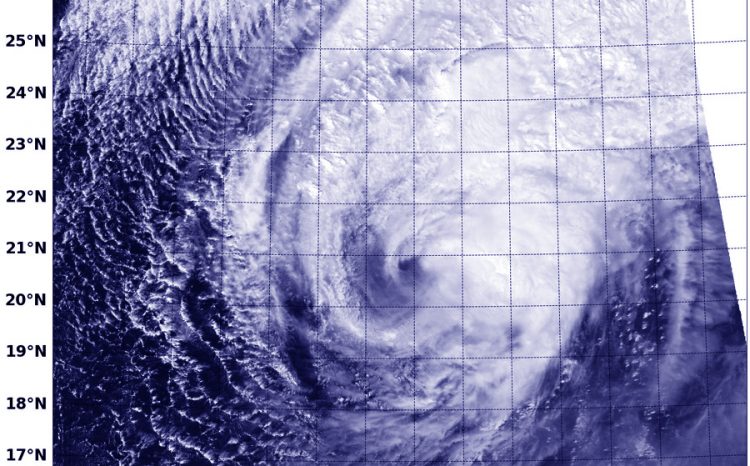NASA Sees Tropical Cyclone Faxai Stretching Out

NASA-NOAA's Suomi NPP satellite passed over Tropical Cyclone Faxai and the VIIRS instrument captured this visible image on Mar. 5 at 03:35 UTC. Image Credit: NRL/NASA/NOAA
On March 5 at 1500 UTC/10 a.m. EST, Tropical Cyclone Faxai's center was located near 22.5 south and 155.2 east, about 699 nautical miles/804.4 miles/ 1,295 km west-northwest of Wake Island.
According to the Joint Typhoon Warning Center or JTWC, Faxai's maximum sustained surface winds dropped to 50 knots/57.5 mph/92.6 kph. Faxai was moving to the northeast at 14 knots/16.1 mph/25.9 kph and quickly weakening.
NASA-NOAA's Suomi NPP satellite passed over Tropical Cyclone Faxai on Mar. 5 at 03:35 UTC and the VIIRS instrument or Visible Infrared Imager Radiometer Suite aboard captured a high-resolution visible image of the storm.
VIIRS is a scanning radiometer that collects visible and infrared imagery and radiometric measurements. VIIRS data is used to measure cloud and aerosol properties, ocean color, sea and land surface temperature, ice motion and temperature, fires, and Earth's albedo.
The VIIRS image showed that Faxai had become elongated as a result of increasing vertical wind shear. The VIIRS image also showed cold air stratocumulus clouds were moving into the western quadrant of the storm.
The JTWC noted that all strong convection (rising air that forms thunderstorms that make up a tropical cyclone) has dissipated. Satellite imagery also showed that Faxai was taking on frontal characteristics.
The JTWC issued their final bulletin on Faxai and noted that the storm was expected to become extra-tropical by the end of the day on March 5 as it becomes embedded into a westerly flow.
Text credit: Rob Gutro
NASA's Goddard Space Flight Center
Media Contact
All latest news from the category: Physics and Astronomy
This area deals with the fundamental laws and building blocks of nature and how they interact, the properties and the behavior of matter, and research into space and time and their structures.
innovations-report provides in-depth reports and articles on subjects such as astrophysics, laser technologies, nuclear, quantum, particle and solid-state physics, nanotechnologies, planetary research and findings (Mars, Venus) and developments related to the Hubble Telescope.
Newest articles

How Geothermal Energy Shapes Bavaria’s Green Future Through Sustainable Energy
The Bavarian State Ministry of Science and the Arts has extended its funding for the research association “Geothermal Alliance Bavaria,” with the University of Bayreuth (UBT) continuing as a member…

Spintronics memory innovation: A new perpendicular magnetized film
Long gone are the days where all our data could fit on a two-megabyte floppy disk. In today’s information-based society, the increasing volume of information being handled demands that we…

Materials with a ‘twist’ show unexpected electronic behaviour
In the search for new materials that can enable more efficient electronics, scientists are exploring so-called 2-D materials. These are sheets of just one atom thick, that may have all…



